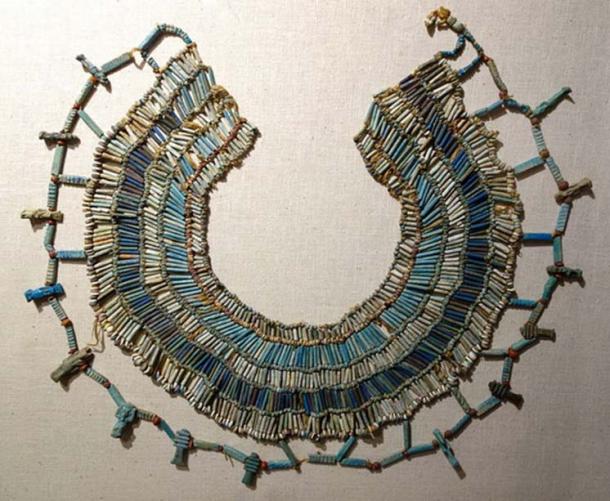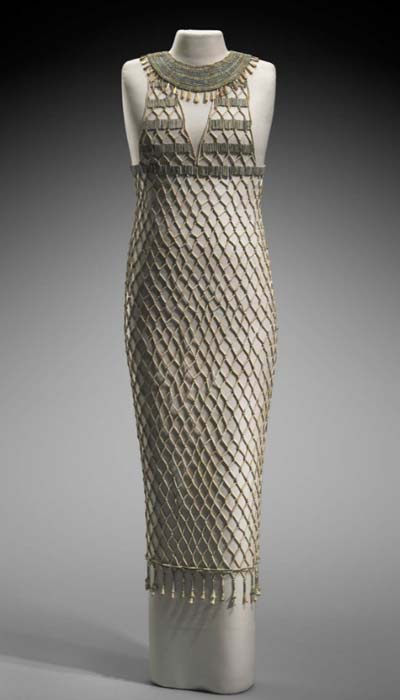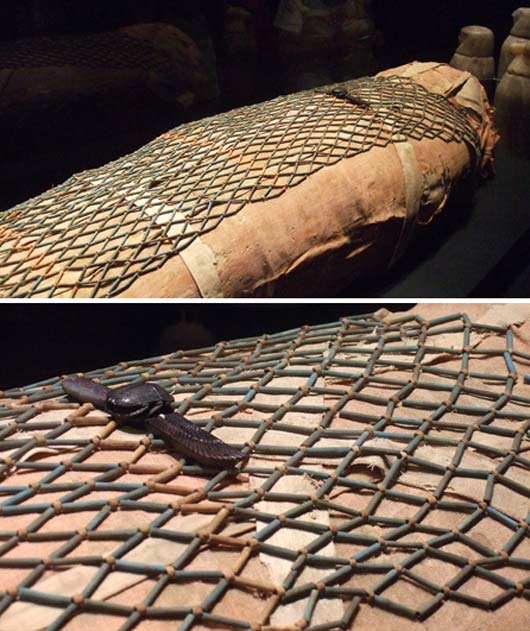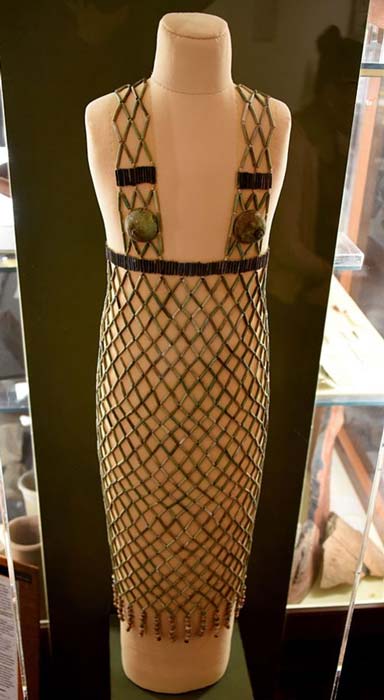
High Fashion of Ancient Egypt: The Bead-Net Dress
Fashion trends are not just a modern construction. In ancient Egypt, looking fashionable was an important part of everyday life, especially for the elite members of society. One of the high class fashions was the bead-net dress. Although historians were aware of artistic depictions of females wearing bead-net dresses, it wasn’t until the 1920s that real examples were actually discovered.
Bead-net dresses were made with thousands of beads arranged in a lozenge pattern, and although it is believed that women wore such dresses in daily life, most examples have been found in burials. These precious garments are extremely rare, as only 20 of them are known at present. They are kept in various museums around the world.
Fashionable Beads
Articles of clothing made of beads were considered to be a fashion amongst ancient Egyptian women. Priestesses, for instance, wore beaded headdresses and beaded collars. Upper class women also wore nets of faience beads across the middle third of their tunics for festive occasions. For poorer women, they had to be content with a string of beads around their waists. Unlike these bead collars and bead strings, bead-dresses are not so much accessories as they are pieces of clothing in their own right.

A beaded necklace from ancient Egypt, 664-332 BC, faience, carnelian, and limestone beads (public domain)
Bead-Net Dresses
It has been suggested that bead-net dresses may have been made in one of two ways. The first is that the beads could have been sewn directly onto a woman’s linen dress as part of this piece of clothing. The second method is that the beads were strung together on a net which was then worn over a linen dress. Some of these dresses, such as the one in the possession of the Museum of Fine Arts, Boston, were made using blue and blue-green faience beads, which were meant to be an imitation of lapis lazuli and turquoise respectively.

The stunning bead-net dress currently on display in the Boston Museum. Photo source: Museum of Fine Arts, Boston.
Bead-Net Dresses in Art and Literature
Bead-net dresses have been found to be depicted on ancient Egyptian reliefs and statues. One example of this is a statue of the sky goddess, Nut, from the 3 rd millennium B.C. This statue depicts the goddess dressed in a piece of clothing that looks very much like a bead-net dress.
In addition, bead-net dresses are also mentioned in a piece of ancient Egyptian literature, i.e. the collection of stories known as the Three Tales of Wonder (known also as the Tales from the Westcar Papyrus). In one of these stories, known as The Story of the Green Jewel, King Snefru was looking for entertainment in his palace, and he was advised by his chief scribe to go boating on the lake, and have for his rowers the prettiest girls in the king’s harem. In addition, these female rowers, according to one translation, were dressed in nets, presumably the bead-net dresses, instead of normal dresses, for the king’s pleasure.

A mummy covered in a bead-net (Proletariat Fashionista)
As for actual bead-net dresses that have survived till today, these have been mostly found in tombs. For instance, the bead-net dress in the Petrie Museum of Egyptian Archaeology, London is from a 5 th / 6 th Dynasty tomb in Qau, a city in Upper Egypt. This bead-net dress was discovered in 1923/4, and it was initially suggested that the dress might have been worn by a dancer. Around the fringes of this dress were shells plugged with small stones, which made a rattling sound when the wearer moved. Therefore, it was thought that the dress may have been used for erotic dances.

Faience, blue and black cylinder beads, 2 breast caps and 2 strings of Mitra beads. 5th Dynasty. From burial 978 at Qau (Tjebu), Egypt. The Petrie Museum of Egyptian Archaeology, London. (CC by SA 4.0)
When this dress was reconstructed, however, it was found that it would have been rather heavy for a dancer to move in it, let alone dance in it. Given that the dress was found in a tomb, it has been speculated that they served a funerary function instead. The bead-net dress in the Petrie Museum is not the only one that was found in a tomb. The own in the Museum of Fine Arts, Boston, for example, was discovered in a tomb in Giza, and dates to the 4 th Dynasty, specifically to the reign of Khufu.
Top image: Main: Earliest surviving beadnet dress with the lozenge pattern (CC by SA 3.0). Inset: A bead-net dress. Photo source: Museum of Fine Arts, Boston.
By Wu Mingren
References
Egypt, T., 2017. Egypt: Ancient Egypt Dress, Adornment and Body Care. [Online]
Available at: http://www.touregypt.net/historicalessays/lifeinEgypt9.htm
Elrazzaz, M., 2012. Ancient Egyptian beauty exhibited at the Egyptian Museum of Barcelona. [Online]
Available at: http://english.ahram.org.eg/News/38812.aspx
Ewen, M., 2016. Women and Beads: Ancient Egypt to the Jamestown Colony. [Online]
Available at: http://blogs.ucl.ac.uk/researchers-in-museums/tag/bead-net-dress/
Harris, E., 2015. Ancient Egyptian Magic. Newburyport, Mass.: Weiser Books.
Mackenzie, D., 1907. The Tales from the Westcar Papyrus, from Egyptian Myth and Legend. [Online]
Available at: http://www.reshafim.org.il/ad/egypt/texts/westcar_papyrus.htm
Museum of Fine Arts, Boston, 2017. Beadnet dress. [Online]
Available at: http://www.mfa.org/collections/object/beadnet-dress-146531
Sola Rey, 2016. Beauty and fashion in Ancient Egypt.. [Online]
Available at: http://solarey.net/another-ancient-egyptian-beaded-dress/
The BBC, 2014. Qau Bead-Net Dress. [Online]
Available at: http://www.bbc.co.uk/ahistoryoftheworld/objects/v-7XQKM6QkSEO3azbuq6Ww















